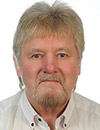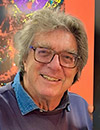Plenary Event
Co-located: Optical Metrology Plenary Session
23 June 2025 • 16:00 - 17:40 CEST | ICM, Saal 1
16:00 to 16:10
Welcome and Introduction
Jörg Seewig, Technische Univ. Kaiserslautern, Germany
Pietro Ferraro, CNR, Institute of Applied Sciences & Intelligent Systems (ISASI), Italy
Symposium Chairs
16:10 to 16:55
The wide scale range of optical measurement technology and its exploration

Wolfgang Osten
Univ. Stuttgart, Institut für Technische Optik, Germany
High quality standards are a must for the majority of manufacturers in all industrial branches. Above all, optical principles have some exceptional properties that make them indispensable for use in all aspects of quality control. To them belong in particular the contactless and high speed interaction with the object under test, the largely free scalability of the dimension of the measuring tool, the high resolution of the measured data, the diversity of information channels transported by the light field, and the flexible adaptability of the measuring standard – the wavelength of light. However, to the outstanding unique selling points of the technology belong especially the extremely wide scale range of the objects that can be examined, their modalities and dimensions.
Wolfgang Osten received the MSc/Diploma in Physics from the Friedrich-Schiller-University Jena in 1979. From 1979 to 1984 he was a member of the Institute of Mechanics in Berlin working in the field of experimental stress analysis and optical metrology. In 1983 he received the PhD degree from the Martin-Luther-University Halle-Wittenberg for his thesis in the field of holographic interferometry.
16:55 to 17:40
The intelligent microscope at the nanoscale: multimodal microscopy from fluorescence to label-free

Alberto Diaspro
Univ. of Genoa and CNR-IBF, Italy
Advanced optical microscopes, from fluorescence-based super resolved methods to quantum optical microscopy, are analytical instruments able to produce images that are rich sources of quantitative information towards an unprecedented insight into the molecular mechanisms that govern and determine the fate of living cells. Their developments are positioned at the interface between biology and physics. Multimodal optical microscopy is a growing attitude boosted by artificial intelligence that makes intelligent the microscope. Definitely, fluorescence plays a key role coupling microscopy and spectroscopy by adding to image formation photochemical parameters, from brightness to lifetime, and non-linear approaches, like those associated with multi-photon excitation able to exploit intrinsic fluorescence and SHG/THG. In this framework, polarization methods like Mueller matrix microscopy expand those contrast mechanisms available for imaging towards labe-free. Such an “optical and probe” based state of the art is boosted by the growing use of artificial intelligence and the increasing availability of single photon detectors. The microscope becomes intelligent with the ambitious target to create a robust virtual environment "to see "what we could not perceive before". An interesting case study is related to understanding the visualization of chromatin organization.
Alberto Diaspro is a biophysicist, Full Professor of Physics at the University of Genoa and Director of Research in Nanoscopy at IIT. He has published over 500 scientific articles. He mainly works in optical nanoscopy and nanoscale biophysics. He received the Emily M. Gray Award from the Biophysical Society and the award for scientific communication from the Italian Physical Society. In 2022, he received the international Gregorio Weber Award for excellence in studies concerning fluorescence. In 2024, he was awarded the honour of Knight of the Order "of Merit of the Italian Republic" and the Enrico Fermi Prize for Physics from the SIF "for original contributions to the development and application of optical microscopy and the crucial impact on cellular and molecular biophysics". He also received the Sant'Eligio Special Prize from Federpreziosi and the "Beppe Pericu" Prize from the Società di Letture e Conversazioni Scientifiche of Genoa for scientific activity and dissemination in 2024.
Welcome and Introduction
Jörg Seewig, Technische Univ. Kaiserslautern, Germany
Pietro Ferraro, CNR, Institute of Applied Sciences & Intelligent Systems (ISASI), Italy
Symposium Chairs
16:10 to 16:55
The wide scale range of optical measurement technology and its exploration

Wolfgang Osten
Univ. Stuttgart, Institut für Technische Optik, Germany
High quality standards are a must for the majority of manufacturers in all industrial branches. Above all, optical principles have some exceptional properties that make them indispensable for use in all aspects of quality control. To them belong in particular the contactless and high speed interaction with the object under test, the largely free scalability of the dimension of the measuring tool, the high resolution of the measured data, the diversity of information channels transported by the light field, and the flexible adaptability of the measuring standard – the wavelength of light. However, to the outstanding unique selling points of the technology belong especially the extremely wide scale range of the objects that can be examined, their modalities and dimensions.
But the trend of modern technologies shows an continued miniaturization of the critical features to be measured, an increasing complexity of the fabricated objects and their extended functionality. Consequently, the user is confronted with a number of serious challenges. Some of the biggest challenges that currently attract high attention in both technical and life sciences, are directed to exceeding the physical limits of optical resolution, to improve the precision of the measurement, and to be ready for the exploration of exotic materials. Therefore optical measurement methods are subject to constant improvement. The characteristics that give rise to improve the performance of the systems are obviously dependent on the purpose of the measurement and the object under test. But there are also general features that can be used to assess the performance of a measurement system. To them belong especially the spatial and temporal resolution, the area related resolution, the precision, the trueness of the delivered data, the robustness against external influences, the degree of automation, the process capability and the ability to work as close as possible to the process.
After an explanation of my understanding of the wide scale range of optical metroloy and a short excurse in its history, we describe some important fields of application and the optical principles used there. Finally, we give an overview of the challenges with which the measurement technology is currently confronted and illustrate this on example of several new measurement devices.
Wolfgang Osten received the MSc/Diploma in Physics from the Friedrich-Schiller-University Jena in 1979. From 1979 to 1984 he was a member of the Institute of Mechanics in Berlin working in the field of experimental stress analysis and optical metrology. In 1983 he received the PhD degree from the Martin-Luther-University Halle-Wittenberg for his thesis in the field of holographic interferometry.
From 1984 to 1991 he was employed at the Central Institute of Cybernetics and Information Processes ZKI in Berlin making investigations in digital image processing and machine vision. Between 1988 and 1991 he was heading the Institute for Digital Image Processing at the ZKI. In 1991 he joined the Bremen Institute of Applied Beam Technology (BIAS) to establish and to direct the Department Optical 3D-Metrology till 2002. From September 2002 till October 2018 he has been a full professor at the University of Stuttgart and director of the Institute for Applied Optics. From 2006 till 2010 he was the vice rector for research and technology transfer of the Stuttgart University.
His research work is focused on new concepts for industrial inspection and metrology by combining modern principles of optical metrology, sensor technology and digital image processing. Special attention is directed to the development of resolution enhanced technologies for the investigation of micro and nano structures.
Wolfgang Osten is fellow of OSA, SPIE, EOS, SEM, IAAM, and senior member of IEEE. He is a Honorary Professor of the Shenzhen University, China, a Honorary Doctor of the University of Technology of Ilmenau, Germany, the 2011 recipient of the Dennis Gabor Award of the The International Society for Optics and Photonics SPIE, the 2018 recipient of the Rudolf Kingslake Medal of the SPIE, the 2019 recipient of the Chandra Vikram Award of the SPIE, and the 2019 recipient of the Emmeth Leith Medal of the Optical Society OSA.
16:55 to 17:40
The intelligent microscope at the nanoscale: multimodal microscopy from fluorescence to label-free

Alberto Diaspro
Univ. of Genoa and CNR-IBF, Italy
Advanced optical microscopes, from fluorescence-based super resolved methods to quantum optical microscopy, are analytical instruments able to produce images that are rich sources of quantitative information towards an unprecedented insight into the molecular mechanisms that govern and determine the fate of living cells. Their developments are positioned at the interface between biology and physics. Multimodal optical microscopy is a growing attitude boosted by artificial intelligence that makes intelligent the microscope. Definitely, fluorescence plays a key role coupling microscopy and spectroscopy by adding to image formation photochemical parameters, from brightness to lifetime, and non-linear approaches, like those associated with multi-photon excitation able to exploit intrinsic fluorescence and SHG/THG. In this framework, polarization methods like Mueller matrix microscopy expand those contrast mechanisms available for imaging towards labe-free. Such an “optical and probe” based state of the art is boosted by the growing use of artificial intelligence and the increasing availability of single photon detectors. The microscope becomes intelligent with the ambitious target to create a robust virtual environment "to see "what we could not perceive before". An interesting case study is related to understanding the visualization of chromatin organization.
Alberto Diaspro is a biophysicist, Full Professor of Physics at the University of Genoa and Director of Research in Nanoscopy at IIT. He has published over 500 scientific articles. He mainly works in optical nanoscopy and nanoscale biophysics. He received the Emily M. Gray Award from the Biophysical Society and the award for scientific communication from the Italian Physical Society. In 2022, he received the international Gregorio Weber Award for excellence in studies concerning fluorescence. In 2024, he was awarded the honour of Knight of the Order "of Merit of the Italian Republic" and the Enrico Fermi Prize for Physics from the SIF "for original contributions to the development and application of optical microscopy and the crucial impact on cellular and molecular biophysics". He also received the Sant'Eligio Special Prize from Federpreziosi and the "Beppe Pericu" Prize from the Società di Letture e Conversazioni Scientifiche of Genoa for scientific activity and dissemination in 2024.
